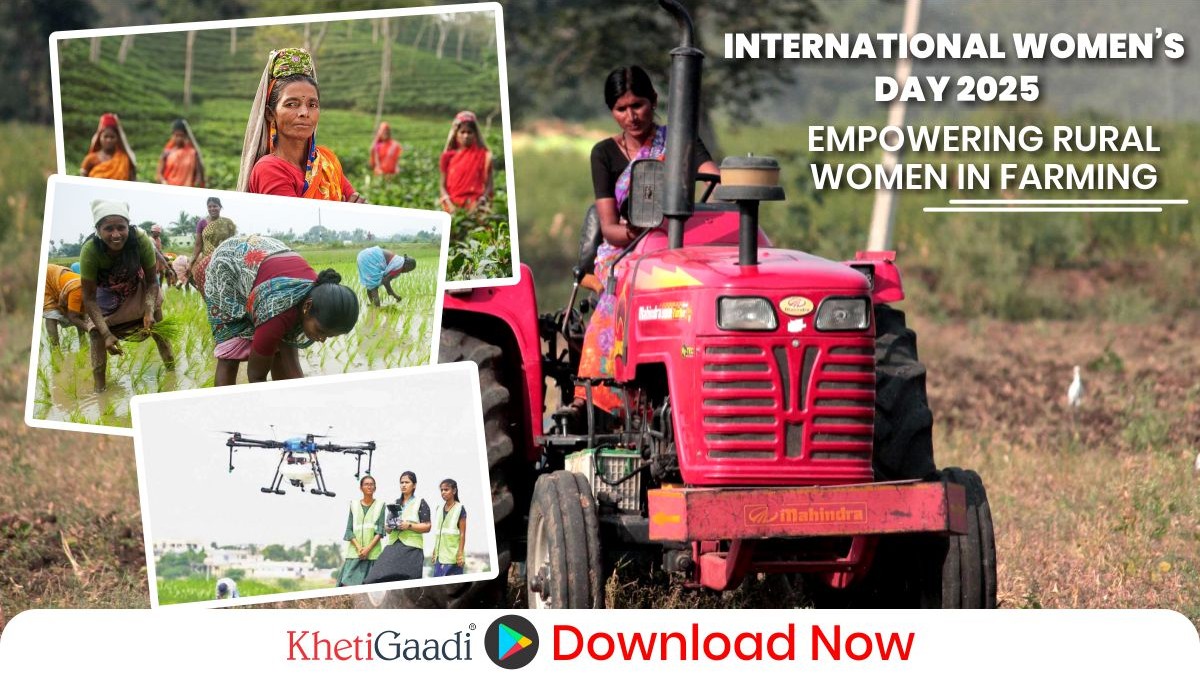International Women’s Day 2025: Honoring Women in Indian Agriculture!
International Women’s Day 2025 will pay tribute to women and their contributions. Initiatives like reservations in Panchayats, Aajeevika, and MGNREGA have enabled them to become more independent and empowered, with privileges and rights that guarantee equality and sustainable livelihood options for them in India’s agricultural sector.
International Women’s Day will be observed on March 8, 2025. The White Paper of the Chinese Government on Gender Equality and Women’s Safety under Development presented at the 4th World Conference on Women set forth the main theme, “Equality, Development Security for Women.” Here we present a new material examining progress all over the world over the past fifty years. It has been animated by the idea that those who laboured most deserved most honour. The Progress of Women 1995, known as The Beijing Demystified Report, serves both as evidence for restructuring and a benchmark in judging associates like women’s education. ( JSAP) Women today are stepping onto the fast track more than ever before. Isolated rural women are now a theme of the world scene in which they demand their rights to learning, self-fulfillment, and independence from society’s double standards.
Their invaluable contributions become not merely a fact of rural productivity but also a slow-changing force that ultimately shapes our society. Let us take a moment to salute these rural women; their strength and fortitude form the basis of our agricultural landscape.
International Women ‘s Day 2025: Theme
Women are the great unknown contributors of Indian rural production, which ranges from agriculture to raising and fattening livestock to side-line agribusiness. Their contribution to Indian farming is huge but has never been noticed. This year, as we celebrate International Women’s Day 2025 on 8th March with the theme ‘For ALL Women and Girls: Rights Equality Empowerment, ‘ it is also essential that we recognize the role of women in shaping the agricultural scene of India and call for their empowerment, enhancement, understanding, and support.
Women’s roles in the countryside are fundamentally the same across all regions and periods.
In Indian agriculture, women make up almost 75% of the full-time workforce, taking on a large variety of tasks, including planting, weeding, harvesting, and post-harvest cleaning. But although they work so hard to assist in agricultural production, female agricultural workers receive little respect and lower pay compared with their male counterparts.
The contribution of women to agricultural work is not just limited to farming; thirty percent of household chores such as cooking, washing, and caring for children are borne by them as well. This type of unequal access that women face to such resources as credit, land, and markets needs to be resolved.
But in today’s environment, as government policy changes, increasingly women are being recognized, and this has encouraged them to step outside the home and become literate, self-sufficient, equal citizens. Here, I will introduce several Indian government programs released for the welfare of rural women.
Initiatives of the Governments of India To Empower Rural Women:
Reserving One-Third of the Seats in Panchayati Raj Institutions (PRIs) for Women Candidates
Under the 73rd amendments of the Constitution, 1/3rd seats in the Panchayati Raj Institutions (PRIs) were reserved for women candidates. According to a PIB report in July 2023, over 14.50 lakh Elected Women Representatives (EWRs) exist, accounting for around 46% of the total elected representatives. In addition, the capacity building of these EWRs is being done by providing induction training by the Government of India from time to time.
Official Website: https://panchayat.gov.in/
DEENDAYAL ANTYODAYA YOJANA NATIONAL RURAL LIVELIHOODS MISSION (DAY-NRLM)-AAJEEVIKA
Implemented by the Ministry of Rural Development (MoRD), Deen Dayal Antyodaya Yojana – National Rural Livelihoods Mission (DAY-NRLM) aims to bring rural poor women into the fold of the Self Help Groups (SHGs) and continue to support them till they achieve self-sustainability and an adequate growth in their income over some time. This initiative has enabled rural women to uplift their living standards and rise above poverty. Till 30th June 2024, DAY-NRLM has already been implemented in 7135 blocks in 742 districts of 28 States and 6 UTs. The mission has also succeeded in mobilizing 10.05 crore women into more than 90.86 Lakh SHGs.
Official Website: https://aajeevika.gov.in/
Lakhpati Didi Plan
One hundred thousand rupees at household level for a year if a member of this group earns upwards then he/she is a called Lakhpati Didi. It is the time to make this money last a sort of lifetime– at least four farm time of cycle, or eight runs for business 10 k run five rupee is taken a hungry belly and a long time is left for not starving. This measure infuses funds in girls’ groups and makes the road model able to follow sustainable lifestyles (farming or non-farming activities), making good human resource management and following a scale of living.
Under the program, women are mistresses and guarded by the government to some certain optimistic. Every year, training sessions for women are regularly organized in collaboration with government sector plans for financial literacy, skills training, and counselling. As well, the program goal is to pride in that shg memn can the enterprise field Welcome themselves in business.
Official Website: https://lakhpatididi.gov.in/
MGNREGA Act, 2005
The MGNREGA Act was launched on September 25, 2005. It guarantees employment for one hundred days a year of unskilled manual work to one member of every rural household who is willing to work. Hence, under the act, 33% of NREGA jobs will be reserved exclusively for women who applied for jobs or asked for work instruments under the Employees’ State Insurance Corporation from the central pool. The plan also leaves room for mileage targets to be extended proportionately after 1990 to neutralize surprises of inflation or crop failure. But this is not enough.
Official Website: https://nrega.nic.in/MGNREGA
Beti Bachao, Beti Padhao
Prime Minister Narendra Modi launched the Beti Bachao, Beti Padhao program on 22nd January 2015 in Haryana. As per the program, it should have the following objectives − Balance the Sex Ratio, protect and promote the welfare of girl children, educate the girl children. This initiative, which has been praised across India, quickly showed signs of success by the end of 2015. For the first time, a state crept above 900. This has become pervasive.
Official Website: https://wcdhry.gov.in/schemes-for-women/beti-bachao-beti-padhao/
Pradhan Mantri Matru Vandana Yojana (PMMVY)
PMMVY was launched by the Government of India in 2017 under section 4 of the National Food Security Act (NFSA), 2013. Sc/ST category women On Below Poverty Line Pregnant and lactating women are given financial aid in the scheme. The scheme is aimed at improving maternal and child health as well as making up for their work losses during labour.
Official Website: https://wcd.delhi.gov.in/wcd/pradhan-mantri-matru-vandana-yojana-pmmvy
As we mark International Women’s Day 2025, appreciation has done its bit. Now, we must take a real step beyond that and give women empowerment. At present, women have no land. Rural and tribal areas need to give them this ”fertile soil” perhaps more than any other sector of society combined! Therefore, if rights haven’t been granted as yet but should be, Women in agriculture are not only contributors but also leaders and innovators. Investing in them is fundamental to India’s food security and economic future.
Stay connected to the KhetiGaadi WhatsApp channel and get the latest updates on farming innovations and government schemes. Visit KhetiGaadi for more information and guidance.
Contact Khetigaadi for guidance and updates on agriculture schemes for farmers:
Phone: 07875114466
Email: connect@khetigaadi.com




